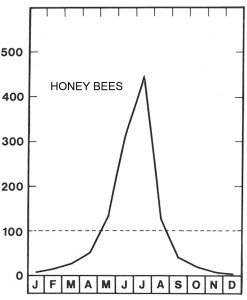
Honeybees only sting in defense. The sting is barbed and is, along with the venom sac, modified so it stays in the victim. The bee dies afterwards, but the sting can continue to deliver venom.
There is about 0.1 mg venom in one bee sting, and in order for the effect of the venom to be dangerous for an adult human, it probably takes 2000-3000 simultaneous stings. Cases of deaths after bee stings are practically always caused by hypersensitive reactions to one or more of the proteins in the venom, or stings in the throat, which may cause choking.
Bee and hornet venom is similar in composition and effect to snake venom, but the allergens in them are not the same. The species of honey bees that live in Denmark have been kept as livestock through many generations, and through breeding they have become extremely peaceful. The notorious “killer bees” (Africanized honey bees) are a crossing between European bees and an African species that was bred in South America in order to have a more sturdy and active bee. Unfortunately, they are also very aggressive and difficult to deal with, but stories that they seek out and attack animals and humans are exaggerated.
What to do about the sting? The stinger should be removed, but carefully to avoid pressing more venom out of the poison sac. This can be done by scraping it off with a pocket knife.
Bee stings hurt, but usually do not entail complications. There are hardly any of the household remedies: ammonia solutions, sugar, sucking out the venom, plantain leaves, etc., which have more than a psychological effect. Whatever you do, you should keep an eye on the person who has been stung. Is there imminent dizziness or nausea, you should seek medical attention. The same applies to stings in the mouth or throat, since they can lead to swelling that can cause breathing difficulties.
People, who have developed such a degree of hypersensitivity to the bee venom that a single sting can be life threatening, can be treated preventively with vaccines. The treatment is lengthy, so it is necessary to start the treatment well before the bee season starts.




